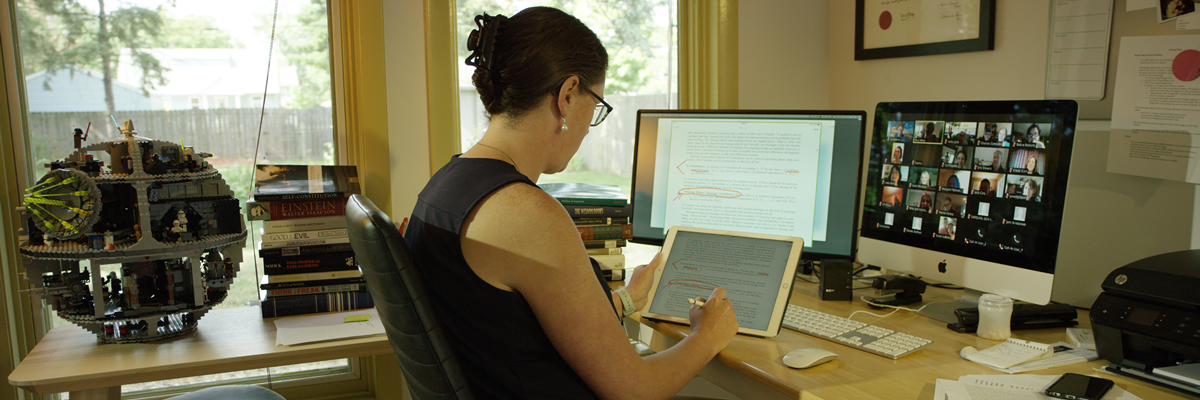www.youtube.com/watch?v=zpSTPU1nErs
The Moreau First Year Experience (FYE) program was created in 2015 to give students a smooth transition from high school to college life at Notre Dame. All incoming freshmen, placed in small groups across 115 individual sections, cover important topics that range from cultural competency and well-being to healthy relationships and academic success.
Because it was new, program creators and course designers wanted to keep an eye on the course to make sure the content was meaningful, so that students would engage with it and not just survive their first weeks of college, but flourish.
Moreau course materials are delivered through Sakai and give students a visually attractive layout with an organized workflow, providing every class section the same experience. They are structured around weekly topics which include essays and videos presented as a flipped-classroom experience. Students study the weekly material, then write and submit reflections prior to the in-class discussion, enabling them to discuss the topic on a deeper level.
Creating a sweeping course with the breadth of topics it covers took the work of many people. “One of the really groundbreaking things about Moreau is that it’s a very active partnership between the academic unit of First Year of Studies and the Division of Student Affairs,” explains Maureen Dawson, assistant dean in the First Year of Studies and FYE co-director. Dawson, along with Paul Manrique, program director for New Student Engagement and FYE co-director, worked with instructional designers and learning data scientists to curate and build the FYE course sites in Sakai.
Manrique appreciated glimpses into the learning and program impact that the course’s design has offered. “Sakai allows us to use a week-by-week analysis of where students are,” says Manrique, “ensuring that they’re reviewing material, allowing them to reflect, almost in a diary, on the materials and how they’ve progressed as a student from the fall or the beginning of the semester.”
The FYS course creators collaborated with the Kaneb Center for Teaching and Learning to make the course sites not only an effective learning tool for students, but also a predictive tool for student success. Instructional designer Kevin Abbott and Alex Ambrose, Kaneb’s digital learning analyst, built the Sakai sites to output data based on student activity that answers questions about how students actually engage with the content.
Ambrose explains it this way. “We were able to pull lots of data on how the students were watching videos, how they were reflecting on the ePortfolios, the Google analytics of clicking on different readings, and we were able to see a new layer—a new view of the learning that wasn’t able to be seen before because the students are coming in this portal and we’re capturing their experience.”
“The challenge that we had,” notes Ambrose, “was how do we effectively engage all 2000 students in this one-credit course, and how do we efficiently scale and support over 115 instructors across all these different sections?” They realized they could improve student outcomes if they reviewed and responded to the data. “Not just to administer and manage the learning,” Ambrose explains, “but to transform the learning.”
Dawson noted that the wide variety of skills on the Moreau team, which included those with backgrounds in teaching theory and technology, produced a valuable look at how students learn. “We saw that if articles and videos are too long the viewership, the readership drops off. So very early on we started to understand that there’s a sweet spot for length of readings and length of videos and that’s really all thanks to the analytical research of our colleagues in Kaneb and OIT.”
The size of the Moreau program meant there was a large amount of data from course site activity. “Never have we had such a large group—a pool of 2100 students—to base our observations on,” says Ambrose. Moving forward, there were real questions to answer. “How could we create a digital learning environment, how could we help with the course design, how could we help with the assessment design to make sure that the course was achieving the goals and the outcomes that it set out to do, and that we could actually measure that and make sure it was accomplishing those goals.”
As the course has matured, designers now understand their data is not only valuable in tweaking the course for greater student engagement, but that it can also be used to recognize if a student is falling behind, and that a student’s struggles with the Moreau course could be indicative of larger struggles in their first year. According to Kevin Barry, director of the Kaneb Center for Teaching and Learning and member of the original Moreau design team, it was this emphasis on developing the capacity to assist students within the first three to five weeks that has made the program so special.
“One of the exciting take-aways from this project,” says Ambrose, “is that we know how to set up the back end architecture…to really be able to start serving other large courses like the chemistries, the bios, the calcs, the physics, the intro to engineerings, intro to philosophy, to theology – these courses on our campus that many students go through. How can we set up assignments that are not just efficient but that are also effective and really help students learn earlier, sooner, better? That’s the big take-away for me – that we have some lessons to be shared, particularly to the large scale courses on campus.”
